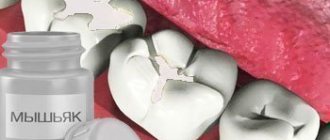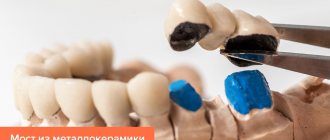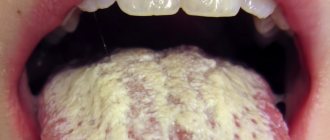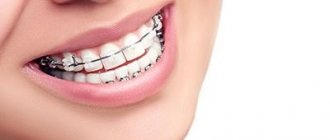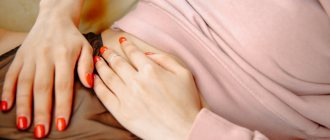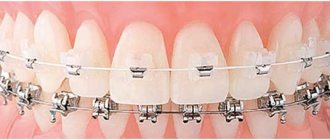Home » Braces systems » What to do if you accidentally swallowed a brace?
Long-term practice of using braces has proven that treatment of crooked teeth and alignment of malocclusion takes a very long time - in some cases, the period can reach 3 years. During this time, troubles related to the correct operation of the correction mechanism should not occur. But this is in theory.
In practice, due to the human factor associated with eating food of inappropriate hardness, sometimes a breakdown occurs, not of the entire system, but of its individual link - the bracket. The brace itself is a small clasp that is attached with glue to the surface of the tooth. In this triple bond of bracket-glue-tooth, the weakest point is the connecting link - the glue. Its composition, since the start of operation of the correction system, has been constantly changing, and the percentage of adhesives in it is constantly decreasing. The fault lies in the food and drinks that a person consumes.
Rarely, but it still happens that the lock-bracket comes off from the main structure, and at the most inopportune moment - while a person is eating. It’s good when this hard element, when chewed, immediately gets between the teeth, thus making itself felt. But it also happens that, unnoticed, it slips further into the stomach along with the food, and only at the end of the meal is its absence discovered.
What to do if the bracket has been swallowed? Let's look at the reasons for braces coming off from teeth, the possible consequences of swallowing both the clasps themselves and the arches with ligatures, and we will also describe ways to solve the problems that have arisen.
What causes braces to come off?
The contact of the lock attached to the surface of the tooth can become loose for several reasons. Each of them can lead to the detachment of the corrective element, and in some cases, to its accidental ingestion. Let's list them:
- Violation of the rules for maintaining the structure . Caring for a brace system is fundamentally different from the rules of oral hygiene. Cleaning of the installed structure must be done strictly after each meal. Irregular and/or insufficient cleaning of the corrective mechanism can lead not only to the appearance of tartar and the onset of carious processes in the area where the braces are attached, but can also cause a weakening of the adhesion of the adhesive composition with which the braces are attached to the surface of the teeth. As a result, due to poor quality cleaning of the system, the possibility of individual braces coming off significantly increases.
- Eating food of improper consistency . As a rule, after installing braces, the orthodontist advises the patient about the presence of certain restrictions on food intake, namely: food should not be hard or excessively sticky. Crackers, chips, chewing gum, etc. should be completely excluded from the diet. When wearing expensive bite-correcting systems, it is extremely important for a patient to maintain their proper functioning and prevent breakdowns. If a patient swallows a broken brace, then most likely the reason may lie in the consumption of a type of food prohibited during treatment.
- Careless handling of braces . The design of such a corrective device, in addition to secondary elements, includes the main ones: locks, arc and springs. We can say with confidence that the strength of a metal arc is very high. However, the strength of the locks and springs leaves much to be desired. This fact imposes certain requirements on the patient in terms of limiting his participation in contact sports - boxing, wrestling and even football, that is, those during which the braces are susceptible to damage.
Causes of fixation disorders
Braces are used in dentistry for abnormal development of dentition. On average, the operation of such structures lasts several years. During this period, it is important to properly care for your braces and monitor their condition and integrity.
The main reasons that lead to violation of fixation are:
- improper oral hygiene. In this case, we mean insufficiently high-quality teeth cleaning. When using braces, it is recommended to use special toothbrushes, irrigators, etc. They allow you to clean hard-to-reach places. Otherwise, the risk of plaque formation and caries development increases, and this greatly affects the quality of the fixing composition;
- excessive consumption of hard or sticky foods. With constant excessive pressure, the system collapses;
- sudden change of hot or cold food. Food that is too cold or hot will affect the quality of the glue;
- jaw injuries. When struck or dropped, there is a possibility of not only the plate coming off, but also the arc breaking.
It is important to know! If a person notices that he is missing part of the structure, he must immediately inform the doctor about it. Delaying the situation leads to the development of undesirable consequences.
Let's figure out together whether it is necessary to remove teeth when installing braces, and for what purpose. Come here if you are interested in the types of combined braces.
At this address https://dr-zubov.ru/ortodontiya/apparaty/brekety/nalogovyj-vychet-za-ustanovku.html we will tell you how to get a tax deduction for installing braces.
What should a patient do if he swallows a brace?
First of all, don't panic. The patient needs to remember: there is no need to worry about possible health complications associated with swallowing one intact brace. This problem does not promise any negative consequences, because modern materials from which orthodontic structures are made are completely harmless to the human body. The brace-lock will not remain inside for a long time; after a while it will come out in the usual way.
In this case, the greatest danger is from a damaged, swallowed bracket. In this case, the patient may experience unpleasant sensations in the abdomen, however, generally speaking, the human esophagus is very adapted to solving this kind of problem: its walls are capable of pushing even a sharp-angled foreign object of small size towards the exit.
In all cases, instead of the lost bracket, a new element will be inserted into the corrective structure. A swallowed bracket is never reused.
Dangers of elements entering the esophagus
Experts say that contact with a structural element is not dangerous for the patient, since orthodontic systems are made from material that is biocompatible with the human body.
The miniature lock will come out naturally during the next act of bowel movement. In this case, the walls of the stomach are designed in such a way that, under the action of muscle muscles, the swallowed lock gradually moves towards the rectum area. The structure is subsequently passed out with feces.
The danger is posed by accidental swallowing of a fragment of the bracket system arch, since it has quite sharp ends that can injure the walls of the esophagus.
Such a situation can lead to the following consequences:
- the formation of a through hole in a hollow organ (perforation);
- inflammatory process in the mediastinum (the space in the middle chest);
- decreased muscle tone;
- partial paralysis of the lower laryngeal nerves.
In this case, the patient is sent for an X-ray examination, which allows the location of the metal fragment to be identified.
More often, the release of the element occurs naturally; in difficult situations, enveloping drugs are prescribed.
Something to remember! If a fragment of the arc gets into the digestive organs, it is strictly forbidden to eat, this will only aggravate the situation and provoke a deterioration in the patient’s condition.
As for the ligature, it is a silicone or wire structural element that is used to secure the arc in the lock. During eating, they often fly off and enter the stomach along with food.
However, swallowing these parts does not pose a particular danger to human health; the silicone elements come out during the next act of defecation, and the wire products are dissolved by gastric juice.
What are the dangers of swallowing wires and ligatures?
An arch in braces is a bent piece of wire. If it is swallowed, there is a real possibility of damage to the soft tissues of the body along its route. The arc may come out naturally, but not always. To insure against possible complications, it is recommended to immediately seek advice from a physician who may prescribe an abdominal x-ray. For a patient in such a situation, it is extremely important not to allow additional food intake, so as not to aggravate an already serious situation. Water and juice are allowed for consumption.
Inhalation of small parts
There are cases of not only swallowing braces, but also inhaling small parts. This situation is considered very dangerous, since there is a risk of the element blocking the access of oxygen to the respiratory organs, including getting into the lungs.
Unfortunately, it is impossible to remove the element from the lung tissue without the help of specialists. A section of a metal arc can block the opening in the trachea or bronchi, thereby causing an attack of suffocation.
If timely assistance is not provided, the patient very quickly begins an inflammatory process, which is accompanied by an abscess.
Self-medication leads to the development of serious complications and poses a direct threat to human life.
In this case, it is necessary to immediately call an ambulance and provide emergency measures to the patient before arriving.
How to put rubber bands on braces
Orthodontic elastic bands for braces are fixed on the teeth according to certain patterns. The type of elastics - their diameter, length, force of influence - is selected by the orthodontist. He also voices the peculiarities of fastening rubber bands on the teeth.
Basic schemes for fastening elastics:
- For two teeth - connect a pair of teeth of the upper and lower jaws.
- Triangle (V-shaped) - the elastic passes through the braces of two upper teeth and through one of the lower jaw. Or vice versa.
- Box fastening - performed on 4 teeth.
- Combined option - the doctor uses several schemes at the same time.
Rubber bands for correct bite provide the desired effect for no more than 12 hours. Within an hour after installation, the latex rods weaken by 30% and soon require complete replacement. Therefore, the patient is trusted to fix the elastics to the teeth - either by hand or using a special device. The tool looks like a large plastic hook. They are convenient for attaching elastic bands to braces. The braces themselves have small hooks on which elastic rings are placed. The treatment plan and teeth for fixing the elastics are indicated by the doctor.
Soldatenkova Alina
Teenagers quickly learn to put rubber bands on braces on their own. The doctor’s task is to ensure that patients accurately select the abutment teeth and do not confuse the places of fixation.
Treatment time is significantly reduced if the patient remembers three rules:
- Wear the braces for a strictly prescribed time - 12 hours (at night) or 24 hours, and remove them while eating and brushing your teeth.
- Replaces elastics every 12 hours when worn daily - morning and evening.
- Change both rubber bands, if at least one breaks - the force of pressure on the teeth on both sides should remain the same.
Reviews
Patients who use braces to correct their bite do not often experience one of the parts getting into their internal organs. In dental practice, however, there have been cases of swallowing a lock, a piece of an arch and a ligature.
This process did not cause serious complications for the patient; the swallowed areas left the body without medical attention. Inhalation of parts of a structure is very rare, but removing them, with modern equipment, does not create difficulties.
If you have experienced braces being swallowed during use, you can share your feelings by leaving a comment on this article.
If you find an error, please select a piece of text and press Ctrl+Enter.
Precautionary measures
To prevent unpleasant incidents, doctors recommend carefully monitoring the integrity of the structure. If you find a missing part or deformation of the system, you should definitely inform your doctor about it.
In addition, it should be remembered that orthodontic systems require proper hygiene procedures and restrictions on the use of certain products.
Precautionary measures also include:
- During operation of the systems, possible injuries to the jaw, impacts, etc. must be avoided.
- Regular visits to the dentist will help avoid the development of caries and other dental diseases, which often lead to structural destruction.
- If a fragment of the structure accidentally comes off, you should not delay a visit to the orthodontist. Otherwise, there is a deterioration in the integrity of the entire system, which negatively affects the process of teeth straightening.
In the video, an orthodontic patient tells her story of swallowing a brace.
Actions of specialists
As a rule, a swallowed foreign object passes through the esophagus and comes out naturally after 3-6 days. Despite the comforting forecasts, X-ray monitoring in a clinical setting is mandatory.
The study will help control the movement of an object through the intestines. If an intact swallowed bracket cannot harm health, then a part of an orthodontic arch that ends up in the digestive tract can become potentially dangerous to a person.
The sharp edges of the wire element can catch on soft tissue as it moves through the digestive tract.
In any case, after swallowing a brace system element, you should consult a doctor. Let us consider in detail the essence of medical care for ingestion of component parts of the structure.
The first action of a doctor upon admission of a patient with complaints of swallowing a foreign body is to classify the object by material, size, shape, and deformation.
To determine the degree of danger of a product, you need to know a number of parameters:
- length (especially important if part of the arc was swallowed);
- shape of edges and surface (sharp, blunt, round);
- material (metal, plastic, sapphire);
- characteristics of radioactivity, chemical inertness.
It is important to note that any metal object that enters the digestive tract can be potentially dangerous. Risks increase if one of the listed factors occurs. For example, at the same time: metal with sharp edges.
A stuck element of the corrective system in the digestive lumen can provoke spasms, pain, difficulty swallowing, and gagging.
Regardless of the characteristics of the part that has entered the digestive tract, mandatory diagnostic studies are carried out. The doctor examines the neck, larynx, pharynx, and also prescribes x-rays and esophagoscopy.
These instrumental research methods make it possible to assess the condition of the walls of the esophagus and identify possible damage.
Thanks to two projections of the x-ray, the specialist can easily examine the x-ray contrast – the bracket, part of the arch, ligature. Based on the data obtained, surgical or conservative treatment is prescribed.
In emergency situations, when there is damage to internal soft structures, therapy is based on the immediate removal of a foreign object from the lumen of the esophagus.
Conservative methods consist of prescribing medications to the patient that have enveloping properties. Furacilin washes and a specially designed short-term diet are also appropriate.
If the above methods are ineffective, the specialist prescribes endoscopy, which allows you to quickly remove the element using a fibroesophagoscope. The procedure is performed under local anesthesia.
If components of the corrective system enter the respiratory tract, a physical examination, laboratory and instrumental diagnostics will be required. The doctor must assess the general condition of the patient, determine vocal tremor, and the color of the skin and mucous membranes.
Clinical tests help evaluate severe bronchopulmonary disorders. The patient also needs to undergo chest X-ray and fluoroscopy.
Non-drug treatment includes physiotherapeutic measures aimed at suppressing inflammatory processes in the bronchopulmonary system. Inhalation therapy has also proven effective.
During surgical treatment, endoscopic interventions are used. The choice of technique is made taking into account the location of the element, the age category of the patient and the severity of adverse consequences.
For reference! Metal objects are removed using magnets.
In the video, the patient will talk about his unpleasant experience of unsticking the braces.
What to do if you accidentally swallow part of the braces system
Parts of the brace system getting into the gastrointestinal tract, especially in children, is not uncommon. If you accidentally swallow the lock, there is no need to worry - it does not contain sharp parts, so it is not dangerous. There is no need to panic if the rubber band - the ligature connecting the arch with the clasps - is swallowed.
The only danger is if parts of the arc with sharp edges get inside the body. In this case, you need to monitor the child’s condition and, if pain occurs, contact a pediatrician. But in most cases, problems do not arise even in this case.
